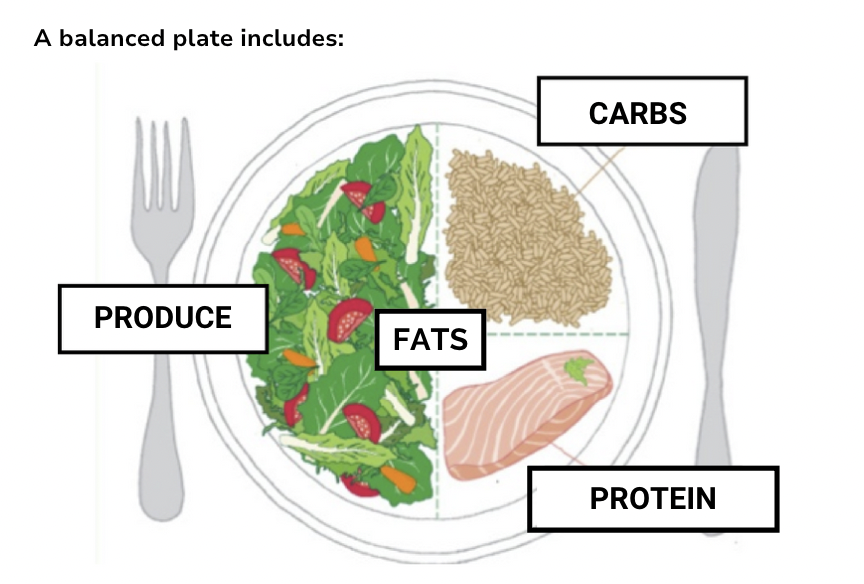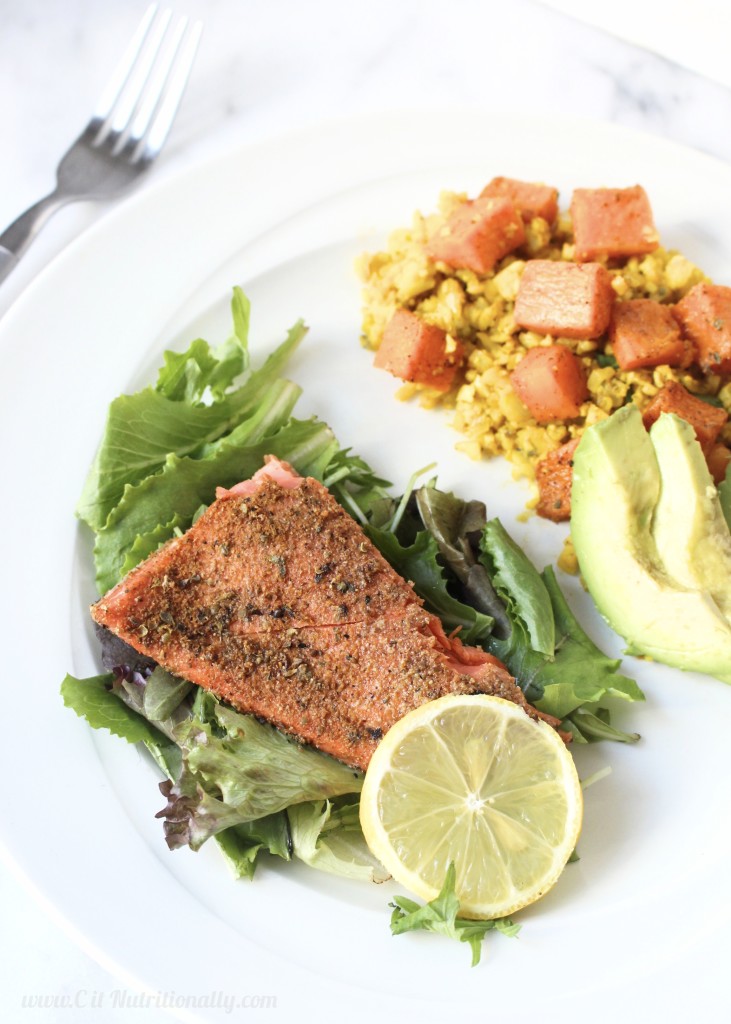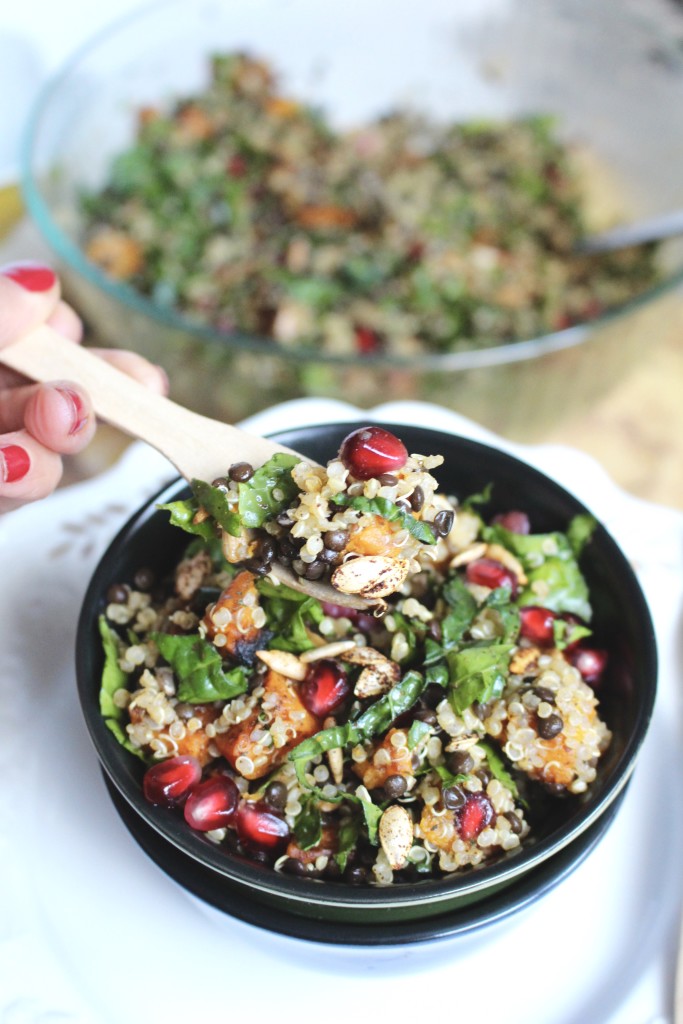Balance Your Plate
Are you looking to boost your nutrition, but don’t know where to start? Today I’m teaching you the basics on how to balance your plate so you can make feel good, healthy eating easy, without dieting and without stress!

Do you ever wish you knew more about nutrition? Do you get confused about all of the headlines out there? Are you eating the RIGHT things?
You’re not alone! I mean, I get confused by the headlines sometimes (because sometimes they just make NO sense!!)…
Let’s talk about BASICS…
How to balance your plate!
Oftentimes when I visit with my highly intelligent, motivated clients I find they lack basic knowledge about nutrition. Sure, they know what gluten is (a protein found in wheat, barley and rye), but they can’t tell me what a carbohydrate is. YUP, those veggies on your plate are carbs!
So even though the basics about balancing your plate are just that — BASICS — they’re necessary to sustain you with long-term, lifelong healthy eating habits.
So let’s break down the basics on how to balance your plate…
There are three major “MACRONUTRIENTS.”
Macro what?!? The big words aren’t as important as knowing that there are three main FOOD GROUPS:
- Carbohydrates
- Protein
- Fat.
Sound familiar?
Aside from alcohol, these are the only three nutrients that provide ENERGY (read: calories). And we need ALL three to function.
Let’s break ‘em down even further…
CARBOHYDRATES
Carbohydrates are found in the common culprits — bread and grains — these are the carbs that most people think of when they “go off carbs” or follow a “low carb” diet. But we NEED carbohydrates!
Carbohydrates are the only form of fuel that your brain uses. Your muscles require carbs to function properly and fuel your workout. And carbs are the quickest form of energy that our bodies can use. So essentially carbs are essential!
What other foods contain carbohydrates?
- Sugar and natural sugar substitutes
- Beans
- Lentils
- Fruit
- Vegetables
- Dairy
DAIRY?! Yup! Dairy contains naturally-occurring carbohydrates (called LACTOSE), which is why even if you’re choose plain yogurt [without added sugar] you will still see a handful of grams of sugar on the Nutrition Facts panel.
It is recommended that about half of your diet is composed of carbohydrates. But this isn’t a free for all telling you to go eat a loaf of bread! Even though, like Oprah, I. LOVE. BREAD.
Most carbs in your diet should be from veggies and fruit.
Since carbohydrates are such a diverse group containing so many different types of foods, let’s break down carbohydrates even more…
- First, there’s STARCH. Starch is a type of carbohydrate found in bread, grains, beans, legumes and starchy vegetables like corn, peas and potatoes. The nutrient profile of starches can vary based on which of these foods you choose to balance your plate. For example, peas contain more vitamins and minerals than white bread.
- Non-starchy vegetables like green leafy vegetables, cucumbers, mushrooms, peppers, eggplant and more are still carbohydrates, but don’t contain starch. They’re higher in…
- FIBER! Fiber is the [largely] indigestible part of some carbohydrates. It helps clean out your digestive system, keeps you full, and provides all sorts of health benefits like lowering your cholesterol, maintaining good blood sugar control and more!
- Fill your plate with fiber to see numerous health benefits!!
PROTEIN
Protein is the building block of muscles, hair and skin, needed to make hormones and brain chemicals (big word: neurotransmitters!) and involved in countless reactions in your body… so it’s obviously important! But in America, we often over-consume protein and don’t need nearly as much as we think (you can read more about that here)!
Needless to say, the average, healthy adult requires about 0.8 grams of protein per kilogram of body weight, or 0.4 grams of protein per pound of body weight. Since I’m not a big fan of counting “macros” (or specific grams of these macronutrients), a good rule of thumb is to have a source of protein at every meal.
What foods contain protein?
- Meat, poultry, seafood and eggs — perhaps the obvious… but there’s more!
- Beans and lentils
- Nuts and seeds (and their butters)
- Greek yogurt
- Soy-based products like tofu, tempeh and edamame
BUT don’t be fooled… vegetables contain protein and whole grains have protein. That’s right…nearly ALL foods contain protein!

FAT
I’ll say it again: Fat does not make you fat!!!
Fat is essential for your body to make hormones, help your brain function optimally, keep your skin and hair healthfully shining and boost satiety. Out of the three macronutrients, fat is digested the slowest so it lingers a little longer in your stomach, which helps keep you full between meals.
Fat also happens to be the most calorically dense — it contains 9 calories per gram of fat (versus 4 calories per gram in carbohydrates or protein), which means even though we need fat, portion control is important too.
What foods contain fat?
- Any oil… and oil-based salad dressings
- Avocado
- Nuts and seeds
- Cheese
Can you spy the 3 sources of fat in this plate…?

So how do you balance your plate?
The easiest way to divide your plate is by following my modified version of the MyPlate guidelines…

Of course this typically needs to be customized to your individual needs ((that’s where a dietitian comes in!)), but using this plate as a model is a great way to start….
- Make the majority of your plate PRODUCE – this can be veggies, a salad, or fruit at breakfast.
- One-quarter of your plate PROTEIN
- One-quarter of your plate a STARCHY CARBOHYDRATE, preferably one that’s high in fiber.
- Sprinkle in some FATS (in cooking or for flavor additions)
My favorite balanced meals:
- Spicy lentil bolognese over zoodles
- Shrimp tacos
- Salmon avocado burgers with a side salad
- Tofu taco lettuce cups
- Warm lentil salad with added greens
But remember… not every “balanced plate” needs to be on a plate or even as compartmentalized as I’ve made it look, but every meal should contain carbohydrates, protein and fats as well… like this quinoa and lentil salad…

I spy lentils and pumpkin seeds (protein), butternut squash and quinoa (starchy carbs) and greens (non-starchy vegetables) with some pomegranate seeds (fruit = carbs) sprinkled in, plus it’s tossed in a light olive oil-based dressing (healthy fats!!).
Working to balance your plate can be overwhelming, but you don’t have to do it alone!
- Learn more in the self-paced Nutrition Training Program!
- Schedule a free consultation to see how you can feel better by balancing your plate.
Soooo… What’s on your balanced plate?!
XO
Disclaimer: This post is NOT meant to substitute for individualized nutrition counseling. As always, listen to your body to nourish it best.


 Hi there!
Thanks for stopping by! I'm Chelsey, an online Registered Dietitian, recipe developer, budding photographer, and coffee addict! My mission is to help you feel good through food by answering the question "What should I eat?" Let's make nutrition approachable!
I hope you enjoy my personal collection of simple, healthy, food allergy friendly and nutritiously delicious recipes, plus tips and tons of tricks that will help YOU live a nutritionally-balanced life! I look forward to getting to know you better...
Hi there!
Thanks for stopping by! I'm Chelsey, an online Registered Dietitian, recipe developer, budding photographer, and coffee addict! My mission is to help you feel good through food by answering the question "What should I eat?" Let's make nutrition approachable!
I hope you enjoy my personal collection of simple, healthy, food allergy friendly and nutritiously delicious recipes, plus tips and tons of tricks that will help YOU live a nutritionally-balanced life! I look forward to getting to know you better...








Good breakdown of the nutrients!
Thank you! Gotta keep that immune system strong!!
Great information.